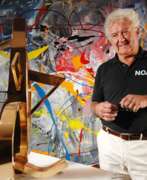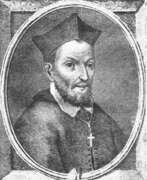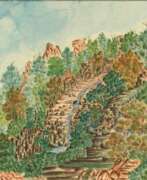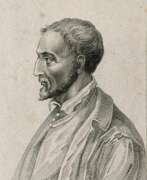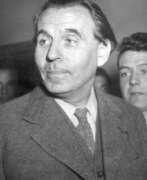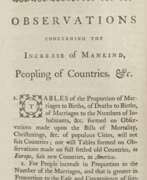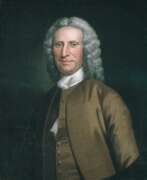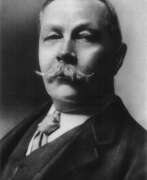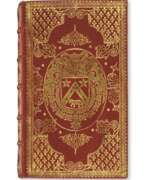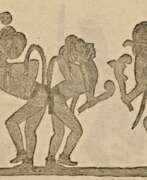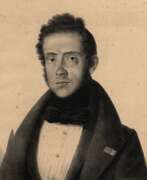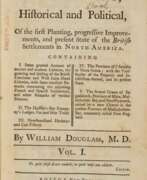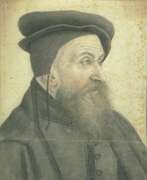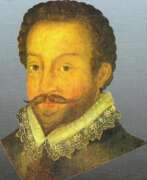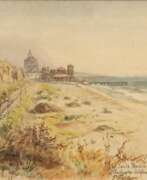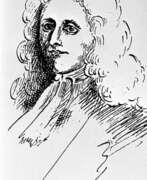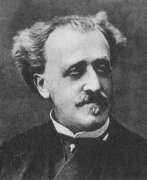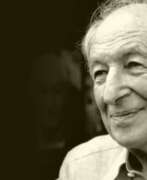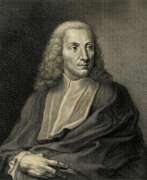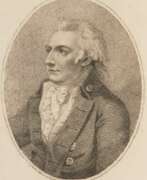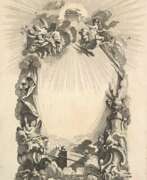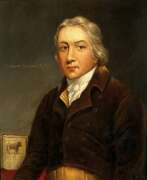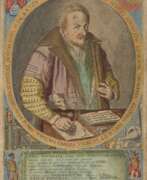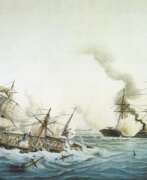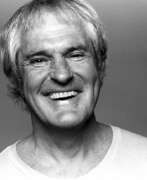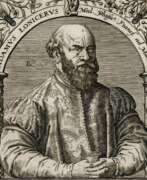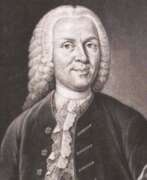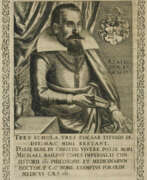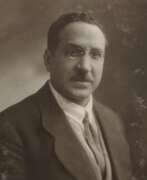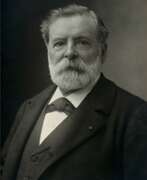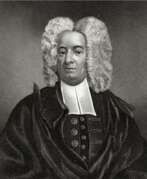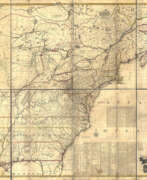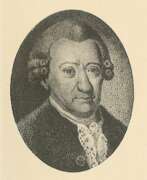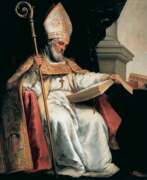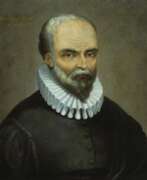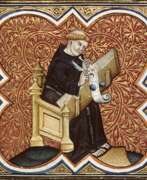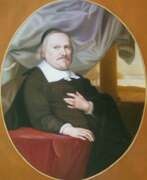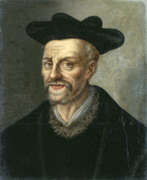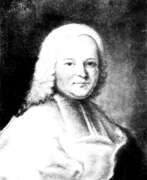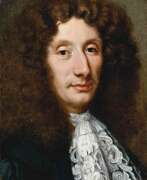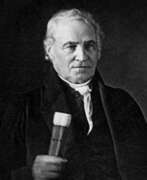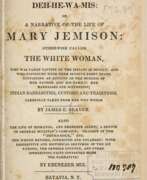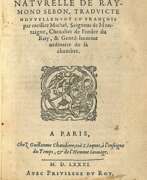Doctors
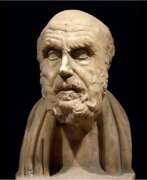

Aratus Solensis was an ancient Greek didactic poet.
It is known that he was a native of the ancient city of Soli in Cilicia, and studied under the famous philosophers of his time in Ephesus, Cos and Athens. Around 276 BC, Aratus was invited to the court of the Macedonian king Antigonus II Gonatus and expounded in verse his victory over the Gauls. Here he also wrote his most famous work in modern times, the hexameter poem Phenomena, which sets forth the astronomical knowledge of the time. He then spent some time at the court of Antiochus I Soter of Syria and returned to Macedonia.
The poet's second extant poem is Diosemeia ("On the Omens of the Weather"). These two poems by Aratus were very popular in both the Greek and Roman worlds. He was translated and quoted by Ovid and Cicerone, and a translation into Arabic was made in the 9th century.
In addition to poetry, Aratus practiced medicine, grammar, and philosophy.
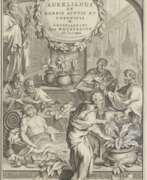

Caelius Aurelianus was a Greco-Roman physician and theorist of medicine, representative of the Methodist school, and author of treatises on medicine.
He is best known for his translation from Greek into Latin of Soranus of Ephesus' lost treatise On Acute and Chronic Diseases. The bilingual and intercultural nature of the text makes it an invaluable contribution to the study of Greco-Roman medicine.
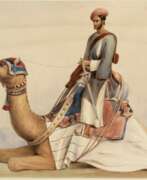

Robert Baikie was a Scottish-born physician, writer and artist.
Baikie spent more than 17 years as a doctor in India with the East India Company's Madras Army, as Chief Medical Officer of the Nilgiris, and has written extensively about the region. It is a fascinating account of the Nilgiri Mountains with maps of the hills and approaches to them, sketches of the scenery, drawings of the principal buildings and tables of routes. This work by Robert Baikie was later published as Observations on the Nilgiri, including an account of their topography, climate, soil and produce.
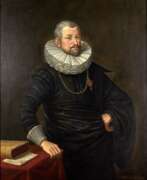

Johann Hartmann Beyer was a German physician, mathematician and statesman.
He earned a master's degree in liberal arts at the University of Strasbourg, and then graduated from the University of Tübingen with a doctorate in medicine. In 1588 Beyer returned to his native Frankfurt and began working as a physician; a year later he was appointed Physicus ordinarius - his duties included overseeing the city's health care and pharmacy system.
In 1614 Beyer took up the position of senior burgomaster of Frankfurt, but during the Fetmilch Rebellion he became involved in conflict, was forced to resign and returned to science.
He had the richest library of scientific books, numbering about 2500 volumes, wrote scientific works on astronomy and mathematics, engaged in medical activity, having invented the famous Frankfurt pills. Beyer carried on a lively correspondence with scientists, including mathematician Johannes Kepler, dealing with decimal fractions. Beyer bequeathed his rich inheritance to the city and to charity.
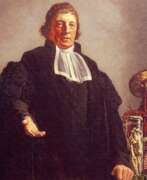

Jan Bleuland was a Dutch physician, medical scientist, educator and writer.
Bleuland was an intellectually advanced man, a sought-after physician, and a rich lover of the arts. Jan Bleuland taught anatomy, physiology and obstetrics for 31 years and was professor and rector of Utrecht University. His talents as a physician and medical researcher were recognized not only by his patients and the scientific community, but also by the highest authorities.
During his lifetime, Jan Bleuland amassed a large collection of medical specimens of the human body, which he used for research. Part of this significant collection is still on display in the original wooden Bleulandkabinet in the Utrecht University Museum. The Bleulandkabinet contains an extensive collection of skeletons, embryos in alcohol and wax preparations of body parts. His pioneering preparations were acquired by Utrecht University by royal decree of King Willem I in 1815 and are still used as teaching material.
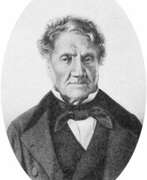

Aimé Bonpland, born Aimé Jacques Alexandre Goujaud, was a French and Argentine natural scientist, traveler, physician, and botanist.
Bonpland became famous for his participation in an expedition to the Americas. Together with the explorer Alexander von Humboldt, he traveled through much of the American territory, from Cuman to the United States, passing through Colombia, Ecuador, Peru, Mexico, and Cuba, in addition to Venezuela. In all these places he did a great deal of botanical work, describing and collecting six thousand species of American plants, many of which were new. The scientist made them known in Europe after his return in 1804, publishing several scientific papers. Four years later, Bonpland was appointed botanist of the Empress's Garden.
After more years, he returned to Buenos Aires and continued numerous botanical, zoological, and medical studies in various regions of South America. Bonpland sent plants to the Museum of Natural History in Paris and maintained correspondence with its naturalists.
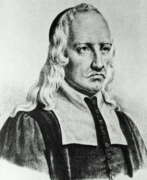

Giovanni Alfonso Borelli was an Italian universalist scientist of the 17th century Scientific Revolution, the founder of biomechanics.
He studied mathematics under Benedetto Castelli (1577-1644) in Rome. In the 1640s Borelli was appointed to the chair of mathematics at the University of Messina and at Pisa in 1656. After 12 years at Pisa and numerous disputes with colleagues, Borelli left the university. In 1667 Borelli returned to the University of Messina, where he engaged in literary and historical studies, studied the eruption of the volcano Etna, and continued to work on the problem of muscular movement of animals and other bodily functions according to the laws of statics and dynamics. In 1674 he was accused of participating in a conspiracy to liberate Sicily from Spain and fled to Rome.
Borelli is known primarily for his attempts to explain muscular movement and other bodily functions according to the laws of statics and dynamics. His best-known work is De Motu Animalium (1680-81; "On the Motion of Animals"). Borelli calculated the forces required for balance in the various joints of the human body, long before Newton published his Laws of Motion. Borelli was the first to realize that musculoskeletal levers increase motion, not force, so muscles must produce much greater forces than those that resist motion. He was also one of the first microscopists: he made microscopic studies of blood circulation, nematodes, textile fibers, and spider eggs. Borelli also authored works on physics, medicine, astronomy, geology, mathematics, and mechanics.
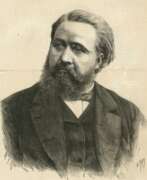

Désiré-Magloire Bourneville was a French physician, neurologist, innovator and educator, and statesman.
Born into a modest family, Bourneville began his medical education in 1860 and for about ten years worked as an assistant to Jean-Martin Charcot, where, together with Paul Régnard, he supervised the publication of "Photographic Iconography of Salpetriere". During the Franco-Prussian War, he served as both surgeon and physician's assistant. Appointed physician at Bissetre, Borneville devoted himself to the medical and educational care of "idiots and epileptics" for whom he organized a service, and later directed the Fondation Vallée in Gentilly until his death. He is considered one of the earliest child psychiatrists.
In 1876, Bourneville was elected a municipal councilor of Paris, three years later he became a general councilor of the Seine, and then a deputy. In this capacity, Bourneville carried out several health reforms: he became the rapporteur for the public assistance budget and the budget for psychiatric asylums, achieved the creation of the first special classes for mentally retarded children, and the first municipal nursing school in Salpêtrière.
Bourneville had many very different talents. Very early on he became interested in medical journalism, where he made a name for himself through the vividness of his articles. In 1873, he founded the journal Progrès Médical, which promoted the tenets of avant-garde medicine, open to pioneering scientific developments (Bourneville published Charcot's lessons) and social issues. He fully developed the theoretical and practical foundations of teaching for the nursing profession. Outraged by the lack of practitioners' professional knowledge of obstetrics, he worked to create a new medical specialty, gynecology. But his main purpose in life was to educate and nurture those who were labeled "idiots" and mentally retarded.
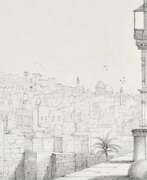

Selina Bracebridge, née Mills, was a British artist, medical reformer, writer and traveler.
Selina studied art with the painter Samuel Prout and traveled extensively, married Charles Holt Bracebridge, and lived in Athens. During the Crimean War, she and her husband worked in the hospital with Florence Nightingale, the founder of modern nursing.
Among Selina Bracebridge's paintings are a famous panorama of Jerusalem taken from the roof of the Governor's Palace, landscapes of Athens and others.
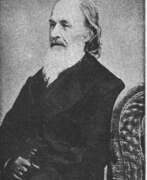

Solyman Brown was an American dentist, creator of the first U.S. National Dental Society and the first U.S. Dental Journal, as well as a poet and artist.
Brown received his bachelor's, master's, and doctor of medicine degrees from Yale University, and also worked as a minister. He wrote many articles explaining dental principles and regulations and became one of the editors of the American Journal and Library of Dental Sciences.
Essentially, in the 19th century, American dentistry was in a terrible state. And Solyman Brown, through all his activism, contributed to the enlightenment and establishment of dentistry in the United States as a true profession and science.
Brown also wrote poetry, articles and essays, and was constantly published in the periodical press. He gained fame and notoriety as a dental poet with his epic "Dentology, a poem on the diseases of the teeth and their proper remedies," which he wrote in 1833. And many more of his poems were devoted to dental diseases, their prevention and treatment. Soliyman Brown, in addition, was a painter and sculptor, painting portraits and creating furniture in wood.
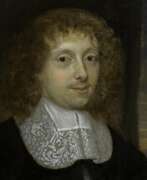

Edward Browne was a British physician, president of the College of Physicians, traveler, historian and writer.
Edward was the eldest son of the famous British scientist Sir Thomas Browne (1605-1682), received a Bachelor of Medicine degree from Cambridge later and a Doctor of Medicine degree from Oxford, and became a member of the Royal Society. In addition to medicine, his subjects of study included botany, literature, and theology. He lived in London and traveled throughout Europe visiting museums, churches, and libraries (Italy, France, the Netherlands, and Germany). In 1673 he published an account of his travels in Eastern Europe, notable for its scrupulous accuracy.
Edward Browne also published two other works: a historical treatise and biographies of Themistocles and Sertorius. He was physician to King Charles II of England and left many manuscript notes on medicine. The chronicle of his journey through Thessaly is a unique and valuable source of information about the region in the second half of the 17th century. He was admitted to the College of Physicians in 1675 and served as its president from 1704 to 1708.
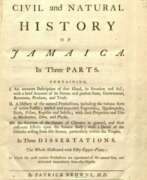

Patrick Browne was an Irish physician and historian, traveler, naturalist and botanist.
Patrick Browne studied medicine in Paris, graduated from the University of Reims, continued his studies in Leiden, and then worked as a doctor at St. Thomas' Hospital in London. Subsequently, he lived for many years in the Caribbean, in Antigua, Santa Cruz, Montserrat and Jamaica, where he practiced medicine. He devoted all his spare time to the study of the natural history of the island. In 1771, Brown returned to Mayo County.
In 1756, Brown published A Civil and Natural History of Jamaica, his most significant work in terms of Carl Linnaeus's botanical nomenclature, which included new names for 104 genera.
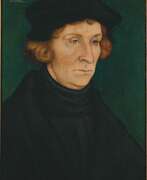

Otto Brunfels (also Brunsfels, Braunfels) was a German theologian, botanist and physician.
After studying theology and philosophy at the University of Mainz, Brunfels went to a Cartesian monastery near Strasbourg and later became interested in botany there. 1524 he opened a school in Strasbourg. In 1530, Brunfels began studying medicine at the University of Basel and two years later became city physician in Bern, where he remained for the rest of his life.
In addition to theological works, Brunfels published works on education, Arabic, pharmacy, and botany. His Herbarium Vivae Icones (1530 and 1536) and Contrafayt Kreüterbuch (1532-1537) contain woodcuts of German plants with their German common names. The 135 original woodcuts are detailed, accurate, and realistic depictions of living plants by the German artist and engraver Hans Weiditz. Brunfels' work contributed to the shift away from medieval outdated herbalism to the establishment of botany as a modern science. Carl Linnaeus considered Brunfels one of the founders of modern botany.
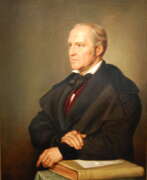

Carl Gustav Carus was a German painter of the first half of the 19th century. He is known as a landscape painter, as well as a scientist, physician (gynecologist, anatomist, pathologist, psychologist) and a major theorist of Romanticism in art.
Carus created idyllic landscapes depicting moonlit nights, mountains, forests, Gothic architecture and ruins. In his work, according to critics, he combined a romantic view of nature with the classical ideal of beauty, understood the beautiful as a triad of God, nature and man. Noteworthy are his small-format, spontaneously created landscape sketches with images of clouds. The master is the author of "Nine Letters on Landscape Painting" - one of the main theoretical works that laid the foundations of the German Romantic school of painting.
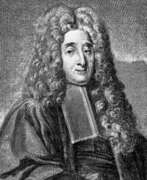

Pierre Chirac was a French physician and chief physician to Louis XV.
Chirac received his Doctor of Medicine degree from Montpellier in 1683, and three years later became professor of medicine. He was elected a member of the Academy of Sciences in 1716, became head of the Royal Garden of Medicinal Plants in 1718, and was appointed physician to Louis XV in 1731. In the 1690s Chirac selflessly and successfully engaged in the treatment of rampant at that time dysentery, yellow fever, smallpox.
Pierre Chirac was one of the leading physicians of his time; with an inquisitive mind, he was interested in several fields of medicine. In 1692, he wrote a significant treatise on cardiology.
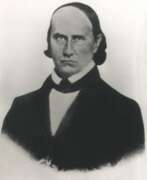

Thomas Holley Chivers was an American physician and poet of the first half of the 19th century.
Chivers earned a medical degree from Transylvania University in Lexington, Kentucky, but rarely practiced medicine. After receiving an inheritance, he was able to live freely and travel. In the early 1830s he traveled extensively throughout the western frontier and the North. He became fascinated with Transcendentalist philosophy as well as slave poetry. A number of Cheevers's poems and plays reflected his ideological views on American Indians and their plight, inspired in part by his interactions with the Cherokee during his frontier wanderings.
During his lifetime, Chivers published eleven volumes of poems, plays, and pamphlets. He also collaborated with the leading literary periodicals and newspapers of the antebellum era, notably the Georgia Citizen, and wrote a biography of Edgar Allan Poe, his friend and soulmate. Nevertheless, the eccentric writer never achieved the critical acclaim he craved all his life.
The friendship between Chivers and Edgar Allan Poe was based on a mutual fascination with metaphysical speculation, as well as on shared literary interests. However, the close cooperation of the two poets was accompanied by a sharp rivalry, in addition, each of them began to consider the artistic borrowings of the other plagiarized. By and large, Chivers is known only for his association with Edgar Poe.
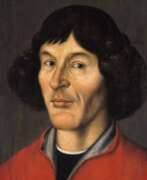

Nicolaus Copernicus (Polish: Mikołaj Kopernik) was a Polish and German scientist, astronomer, mathematician, mechanic, economist, and Renaissance canonist. He was the author of the heliocentric system of the world, which initiated the first scientific revolution.
Copernicus studied the humanities, including astronomy and astrology, at the University of Krakow and at the University of Bologna in Italy. Together with other astronomers, including Domenico Maria de Novara (1454-1504), he was engaged in observing the stars and planets, recording their movements and eclipses. At the time, medicine was closely related to astrology, as the stars were believed to influence the human body, and Copernicus also studied medicine at the University of Padua between 1501 and 1503.
Nicolaus Copernicus, based on his knowledge and observations, was the first to suggest that the Earth is a planet that not only revolves around the sun every year, but also rotates once a day on its axis. This was in the early 16th century when people believed the Earth to be the center of the universe. The scientist also suggested that the Earth's rotation explained the rising and setting of the Sun, the movement of the stars, and that the cycle of the seasons was caused by the Earth's rotation around itself. Finally, he correctly concluded that the Earth's motion in space causes the planets to move backwards across the night sky, the so-called retrograde direction.
Although Copernicus' model was not completely correct, it laid a solid foundation for future scientists, such as Galileo, who developed and improved mankind's understanding of the motion of celestial bodies. Copernicus completed the first manuscript of his book De Revolutionibus Orbium Coelestium (On the Rotation of the Celestial Spheres) in 1532. In it, the astronomer outlined his model of the solar system and the paths of the planets. However, he published the book only in 1543, just two months before his death, and dedicated it to Pope Paul III. Perhaps for this reason, and also because the subject matter was too difficult to understand, but the church did not finally ban the book until 1616.
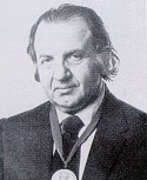

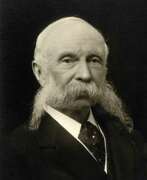

Sir James Crichton-Browne was a British and Scottish psychiatrist, neurologist, and MD.
James studied medicine at the University of Edinburgh, where his interest in psychiatry soon developed. After receiving his MD degree, he worked in hospitals in Derby, Devon and Newcastle. At the age of 26 he was appointed medical superintendent of the Lunatic Asylum in Wakefield and within nine years had transformed the hospital into a leading center for research and treatment.
Crichton-Browne initiated a scientific approach to the brain and its diseases. In 1871 he started the West Riding Asylum Medical Reports, which were published annually for six years. He was a pioneer in combating the common belief at the time that mental asylums could not produce original research and useful science. The persuasive scientist attracted many talented young people to collaborate in his research. Among them were David Ferrier (1843-1928) and Hughlings Jackson, who worked on cerebral localization and epilepsy. In 1878 they together founded what became the famous neurological journal Brain, the first journal devoted to what is now called neurobiology.
Crichton-Browne corresponded extensively with Charles Darwin, providing him with drawings and photographs for his book The Expression of Emotion in Man and Animals. Darwin valued his co-author so much that in 1883 he proposed that he be elected a Fellow of the Royal Society.
Crichton-Browne was also active in the development of public health policy regarding mental health. He worked prolifically into old age, writing monographs and autobiographical material, but in recent years he became involved in the controversial science of eugenics.


Bonetus de Latis or Jacob ben Emanuel Provenzale was a French physician and astrologer of Jewish origin.
Originally from Provence, France, he was a rabbi, and in Rome became physician to Pope Alexander VI and later Pope Leo X. Latis is known mainly as the inventor of the ring-shaped sundial, an astronomical circular dial that could be used to measure solar and stellar altitudes and determine the time with great accuracy both day and night. These clocks were portable and easy to use for navigation. Latis also wrote a treatise known among scholars about the astrolabe ring (1492-1493).
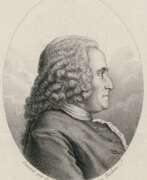

Denis Dodart was a French botanist, naturalist and physician.
Dodart studied at the University of Paris, received a doctorate in medicine and was already in his youth known for his erudition, eloquence and open-mindedness. In 1673 he was elected to the French Academy of Sciences.
He is known for his early studies of plant respiration and growth. Dodart collaborated with the French engraver Nicolas Robert to illustrate his botanical works.
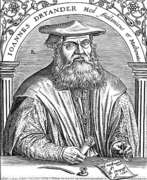

Johann Dryander, born Johann Eichmann, was a German medical anatomist, mathematician and astrologer.
He studied anatomy and medicine at the University of Paris and the University of Erfurt, and in 1535 became professor of medicine at the University of Marburg. A year later, Dryander performed two public autopsies, making the first illustrated description of the dissection of the human brain. Dryander titled his book Anatomiae, hoc est, corporis humani dissectionis pars prior ("Anatomy, that is, the dissection of the human body, part one," suggesting a sequel, which, however, did not follow.
His work made a significant contribution to the development of modern anatomy. Toward the end of his life, Dryander also dabbled in astrology and mathematics.
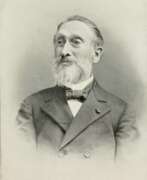

Alphonse Dubois, full name Alphonse Joseph Charles Dubois, was a Belgian naturalist and physician.
Alphonse Dubois had a doctorate in medicine and in 1869 became curator of vertebrate animals at the Royal Museum of Natural History in Brussels. He worked with his father, the academician Charles-Frédéric Dubois (1804-1867), on the publication Les Oiseaux de l'Europe et leurs œufs (The Birds of Europe and their Eggs), completing it after his father's death. The book consisted of two volumes, the second of which consisted of illustrations by Dubois Sr.
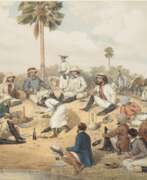

John Dunlop was a British physician and artist.
As Assistant Surgeon of His Majesty's 32nd Regiment, John Dunlop participated in and witnessed the Siege of Multan, Pakistan, a five-month standoff between the city and state of Multan and British East India Company troops in 1848. He made numerous sketches from the scene. Based on his drawings, a work entitled Multan during and after the siege was published. It included 21 drawings by John Dunlop, lithographed by Andrew Maclure, with a descriptive and historical account of the siege.
The siege lasted from April 19, 1848, when a rebellion in the city against a ruler imposed by the East India Company led to the outbreak of the Second Anglo-Sikh War, until January 22, 1849, when the last defenders surrendered.
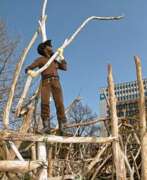

Mo Edoga is a Nigerian-born physician and installation artist who has worked as a doctor in South Africa and as an artist in Germany.
He studied medicine in Heidelberg and first worked as a neurosurgeon in Johannesburg, South Africa. Since 1982 he lived in Mannheim and had a studio. He became famous in 1988 when, after a flood on the Rhine, he collected driftwood and garbage and created his first tower out of them, calling it the "Heavenly Sphere." In fact, his art installations have always been a place where communication has to take place. Mo Edoga liked to talk to people not only about his art, but also about many other topics during the course of his work.
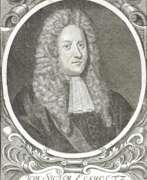

Johann Sigismund Elsholtz (also Elßholtz, Elßholz, Elsholz, Latin Elsholtius) was a German physician, botanist and chemist, a pioneer of hygiene.
Elsholtz studied at the universities of Wittenberg, Königsberg, and Padua, where he received his doctorate. In 1654, he published Anthropometry, written for artists and astrologers as well as students of medicine and physiognomy. The book also explored the supposed relationship between the proportions of the human body and morbidity. Elsholtz was a very versatile scientist and worked in the fields of horticulture, botany, alchemy, astrology, dietetics and medicine, among others.
Elsholtz was later appointed court botanist, alchemist and physician to Elector Friedrich Wilhelm of Brandenburg (1620-1688), and in 1657 was placed in charge of his botanical gardens in Berlin, Potsdam and Oranienburg. In 1672 his treatise Vom Garten-Baw: Oder Unterricht von der Gärtnerey auff das Clima der Chur-Marck Brandenburg was published in Berlin. ("From the Garden Bow or Lessons in Gardening in the Climate of Chur-Marck Brandenburg." It presents the latest gardening techniques for the German climate, discussing flower gardens and their design, vegetable gardens, medicinal gardens, and vineyard care and design.
Elsholtz was a German pioneer in the field of cleanliness and nutrition. Generally speaking, the term "hygiene" first appeared in German in 1682 in his Dietetikon. It is the term he uses to describe the principle of maintaining good health. In his book, the doctor makes recommendations for healthy eating and drinking. He calls for clean water and good air and emphasizes the importance of personal hygiene. Elsholtz was one of the first to administer intravenous injections to people around 1665.
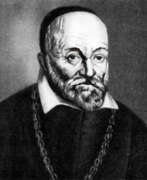

Girolamo Fabrici d'Acquapendente, also known as Girolamo Fabrizio or Hieronymus Fabricius, was an Italian anatomist and surgeon and the founder of embryology. The Latinised form of his name, under which his works can be found, is Hieronymus Fabricius (ab Aquapendente).
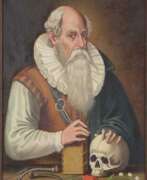

Wilhelm Fabry von Hilden or Fabricius von Hilden (Latin: Fabricius Hildanus) was a German and Swiss Renaissance physician and surgeon, the founder of scientific surgery.
In 1576 he began a four-year apprenticeship as a surgeon with a barber in Neuss. Surgery at that time was considered the craft of bath and barbers; surgeons or wound doctors treated wounds, broken bones, inflammations, and many other ailments. After completing his apprenticeship, Fabry worked for five years as an assistant wound surgeon to Cosmas Slot (died 1585) at the court of Duke Wilhelm V in Düsseldorf. To expand his anatomical knowledge, Fabry constantly dissected and prepared cadavers. In later years, he also encouraged his students to do so and conducted public autopsies to draw attention to the importance of anatomical knowledge. He also made it a habit to do practice procedures on a cadaver before surgery.
In 1615 Fabry was appointed city physician of Bern. Here he wrote several books on gunshot wounds. In 1623 the versatile physician published a small book, "Christian and Good-Hearted Caution against Drunkenness," which he republished in more detail the following year under the title Christlicher Schlafftrunck. Fabry's most important surgical treatise was Observationem et curationem chirurgicam centuriae sex ("Six hundred surgical observations and cures"), first published in 1606. This compilation remained the most important book of German surgery until Lorenz Heister. It describes new surgical methods and surgical instruments for the treatment of amputations, nasal polyps, bladder stones, dropsy, hernias, ascites, etc., etc., etc.
For centuries, Fabricius remained one of the most respected surgeons not only in Germany and Switzerland, but throughout Europe. Among his many accomplishments in the field of surgery may be enumerated his innovation in the amputation of the thigh, for which he invented a special tourniquet; the excision of involved axillary glands in breast cancer; the first classification of burns into three degrees with the appropriate treatment for each variety; and the first description of a medical field chest for military purposes.
Although in his later years Fabritius had already given up practicing medicine, he continued to write medical papers and maintain an active scientific correspondence until his death. He authored some 20 medical books. It was his surgical works, translated into German, French, Latin, English and Dutch, that ensured his recognition centuries later.
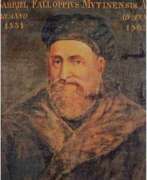

Gabriele Falloppio was an Italian physician and anatomist of the Renaissance.
Originally a priest, Falloppio soon left for Ferrara to study medicine and was later appointed anatomy professor there, and in 1548 he became head of the anatomy department at Pisa. Three years later he accepted the offer of the Venetian Senate to become professor of anatomy, surgery, and botany at Padua, where he remained for the rest of his life. It was in this city that he made his most famous discoveries, was director of the famous botanical garden, and wrote two medical textbooks.
He also gained a reputation as an excellent teacher and lecturer, attracting many Italian and foreign students to the medical faculty of the University of Padua. As a physician, he made a thorough study of the clinical aspects and treatment of syphilis, and proposed the condom as a defense against venereal disease.
Falloppio was a versatile scientist and an able physician and surgeon, describing, among other things, the semicircular canals, the cuneiform sinuses, the trigeminal, auditory and lingual pharyngeal nerves, the canal of the facial nerve, and the fallopian tubes, named Fallopian tubes in his honor. Falloppio described his discoveries in his three-volume work Opera genuina omnia, published in Frankfurt in 1600 and in Venice in 1606.
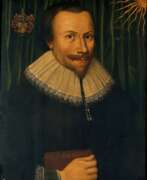

Robert Fludd was a prominent English Paracelsian physician with both scientific and occult interests. He is remembered as an astrologer, mathematician, cosmologist, Qabalist and Rosicrucian.
Fludd is best known for his compilations in occult philosophy. He had a celebrated exchange of views with Johannes Kepler concerning the scientific and hermetic approaches to knowledge.
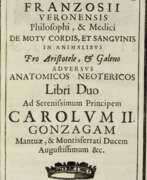

Girolamo Franzosi was an Italian physician and philosopher.
He was born in Polpenazza (now Polpenazze del Garda), near the Lombard lakeshore, in the late sixteenth and early seventeenth centuries. Franzosi was a student at Padua and became a convinced Aristotelian. He opposed the anatomists of the Neoteric Academy, which represented the new trends of medicine in Verona in contrast to the Galenic tendencies of traditional medicine.
Franzosi's other works, written under the influence of Girolamo Cardano and Agostino Nifo, deal with such wide-ranging topics as dreams, prophecies, imagination, and the medicinal properties of viper venom. He printed most of his works in Verona, calling himself "medicus and philosopher of Verona".
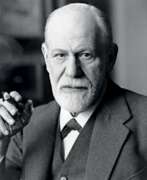

igmund Freud, born Sigismund Schlomo Freud, was an Austrian psychologist, psychiatrist and neurologist, the founder of psychoanalysis.
He graduated from the medical faculty of the University of Vienna, was engaged in self-education and numerous, cutting-edge for his time studies of the human psyche. The resulting psychoanalysis he created was both a theory of the human psyche, a therapy to alleviate its ills, and a tool for interpreting culture and society. Freud's psychoanalysis had a significant impact on psychology, medicine, sociology, anthropology, literature and art in the twentieth century.
Despite the sometimes harsh criticism of virtually all of his ideas and teachings, which continues almost a century after his death, Freud remains one of the most influential intellectual figures of our time.
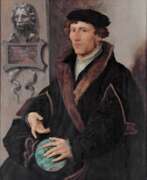

Gemma Frisius, born Jemme Reinerszoon Frisius, was a Dutch mathematician, physician, cartographer, philosopher, engraver, and master of astronomical instruments.
He taught mathematics and medicine at the University of Leuven and applied his mathematical knowledge to astronomy, geography, and map-making. Frisius participated in the creation of the latest globes and used mathematics in geodesy and navigation in new ways and invented or improved many instruments, including the cross staff, the astrolabe, and the astronomical rings (also known as "Gemma rings"). He ran a workshop for making such instruments.
Frisius is credited with being one of the founders of the Dutch school of cartography.
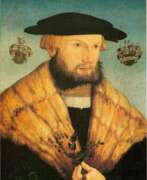

Leonhart Fuchs was a German humanist scientist, botanist, and physician.
Fuchs received a humanistic education under Catholic guidance, but later became a Protestant. He studied medicine and became a professor in Tübingen. He was most interested in the medicinal properties of plants. Well acquainted with the Greek and Latin classics and an excellent observer, he gave precise descriptions, and his beautiful engravings of plants established the tradition of depicting plants with precise illustrations and in alphabetical order.
In 1542 Fuchs published his most important work, De Historia Stirpium Commentarii Insignes (Famous Commentaries on the History of Plants). The book was a great success, especially because of the magnificent woodcuts and the 487 plants, which were described for the first time in such a systematic form. De Historia Stirpium survived several editions and was translated into Dutch and German.
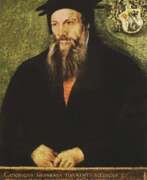

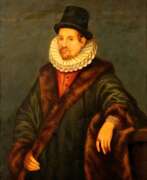

William Gilbert was a British physicist and medical scientist famous for pioneering the study of magnetic and electrical phenomena.
After receiving a medical degree, Gilbert settled in London and began his research. In his major work De Magnete, Magneticisque Corporibus, et de Magno Magnete Tellure (On Magnetic Stones and Magnetic Bodies and the Great Magnet of the Earth), published in 1600, the scientist describes in detail his studies of magnetic bodies and electric attraction.
After years of experimentation, he came to the conclusion that the compass arrow points north-south and downward because the Earth acts as a rod magnet. He was the first to use the terms electric attraction, electric force, and magnetic pole. Gilbert came to believe that the Earth rotates on its axis and that the fixed stars are not all the same distance from the Earth, and believed that the planets are held in their orbits by magnetism.
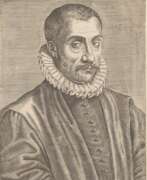

Jacques Guillemeau was a French pioneering surgeon, obstetrician and ophthalmologist.
Born into a family of prominent Orleans physicians, he received a classical education and moved to Montpellier at the age of 21 to study medicine. With the support of his father, a respected surgeon at the court of the French king, Jacques Guillemeau studied under the country's leading physicians. In 1569 Guimault moved to Paris, and in 1574 he succeeded his teacher and royal surgeon Ambroise Paré (1510-1590). Guillemeau assisted Dr. Paré during the war in France and Flanders (1576-1580), and from 1581 he performed surgical operations at the Hotel Dieu hospital in Paris.
During his long career, Dr. Guillemeau earned a reputation as a skilled and experienced surgeon, also publishing several works that gave him a prominent place in the medical community of his time. In 1584, Guillemeau published his "Treatise on Eye Diseases", and in 1585, his "Treatise on the Ailments of the Soul". In 1609, his groundbreaking book "Happy Childbirth in Women" was published. And his "Works on Surgery", written for young surgeons, were regularly reprinted until the middle of the 17th century.
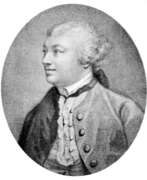

John Hill was a British botanist, pharmacologist and physician, geologist, writer and journalist.
Hill edited the monthly British Magazine for several years, and also wrote a daily society gossip column in The London Advertiser and Literary Gazette. His satirical, often on the edge of propriety articles were often the cause of scandals. Hill also wrote novels, plays, and scientific works on geology, medicine, philosophy, and botany.
In 1759, the first of the 26 volumes of his Plant System was published. This voluminous work contained descriptions of 26,000 different plants and 1,600 illustrations. For this long work, Hill received the Order of Vasa from the Swedish king and began calling himself Sir.
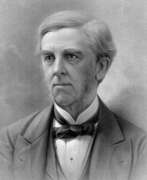

Oliver Wendell Holmes Sr. was an American physician, poet, and humor writer.
Holmes studied law at Harvard University, then medicine in Paris. He practiced medicine for 10 years, taught anatomy at Dartmouth College (Hanover, North Carolina) for two years, and became professor of anatomy and physiology at Harvard in 1847. He later became dean of Harvard Medical School and held that position until 1882. Holmes' most significant contribution to medicine was his research on the contagiousness of postpartum fever. In 1843, he published a treatise on the subject, The Infectiousness of Postpartum Fever. He also introduced the term anesthesia into scientific usage.
Today, Oliver Holmes is remembered as a gifted writer of the 19th century in the United States. Beginning in 1857, he published his "Breakfast at the Table" articles-essays in The Atlantic Monthly and later published several collections written in a conversational style, with Holmes's characteristic humor and wit. He also wrote several poems, three novels, and many poems and anecdotes.
Oliver Wendell Holmes was the father of lawyer Oliver Wendell Holmes, Jr. (1841-1935). According to some sources, he was the prototype of the detective Sherlock Holmes, the famous hero of writer Arthur Conan Doyle.
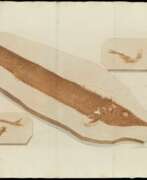

Martinus Houttuyn (Dutch: Maarten Houttuyn) was a Dutch botanist, zoologist and physician.
In addition to his medical practice, Houttuyn practiced science and published many scientific works on natural history, including minerals, fossils, botany and zoology. He was also a keen student of ferns, mosses and seed plants.
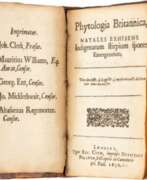

William Howe or How was a British botanist and physician.
He studied at St. John's College, Oxford, earning a bachelor's degree and then a master's degree in medicine. He served briefly in the King's army as a cavalry commander, and later returned to the medical profession and practiced in London.
In his Phytologia Britannica, natales exhibens Indigenarum stirpium sponte Emergentium ("Phytology Britannica"), published in London in 1650, William Howe combined Thomas Johnson's catalogs into a single alphabetical list, supplemented with additional plants from other sources. This was the first edition of the book to compile for the first time all the known plants of Britain with descriptions of their occurrence.
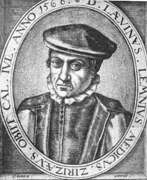

Levinus Lemnius (Dutch: Lieven Lemse, Lenneus, Lennius, Lemmens, Lemnii of Lemnes) was a Dutch physician, philosopher, botanist and writer.
He studied under the famous Swiss botanist and bibliographer Conrad Gesner at the University of Louvain and under the famous Flemish anatomist Andreas Vesalius at the University of Padua. Lemnius's book On the Habit and Constitution of the Body was translated by Thomas Newton, an Anglican clergyman who translated some of Lemnius's treatises into English, as well as other modern continental and classical works.
Lemnius is considered the first author to describe the plants mentioned in the Bible, in T. Newton's translation, Herbal for the Bible (1587). Levin Lemnius's most famous book is Occulta naturae miracula (1559), a book of mysteries that was reprinted many times over a period of four hundred years.
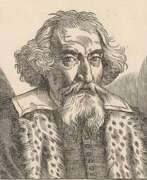

Fortunio Liceti (Latin: Fortunius Licetus) was an Italian physician, natural philosopher, writer and educator.
Liceti studied philosophy and medicine at the University of Bologna and earned doctorates in these disciplines. He taught logic and philosophy at the University of Pisa, and became professor of philosophy at the University of Padua and the University of Bologna. At the University of Padua, Liceti became friends with Galileo Galilei.
Liceti's inquisitive mind was interested in a wide range of subjects: from genetics and reproduction to gems and animals. In general, Fortunio Liceti was a very industrious and prolific scientist: he published a book each year, writing more than seventy works on a wide range of subjects, including the human soul, reproduction, and birth defects.
In 1616, Liceti wrote and published the first edition of De monstruorum causis, natura et differentiis (On the Causes, Nature, and Differences of Monsters), a chronologically ordered catalog of monsters from antiquity to the seventeenth century. Among these monsters were infants with congenital malformations. Liceti was one of the first scholars to attempt to systematically categorize birth defects according to their causes, including numerous causes not related to the supernatural. This topic interested the scientist greatly and he returned to it several times during his life, supplementing it with illustrations, among other things. From 1640 to 1650. Liceti also wrote and published seven different volumes in which he answered questions from famous people on a wide variety of medical topics.
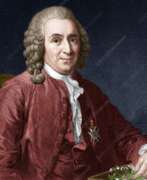

Carl Linnaeus was a Swedish naturalist, botanist and physician.
Carl Linnaeus created a unified system of classification of flora and fauna, in which he summarized and organized the knowledge of the entire previous period of development of biological science. He was the first to formulate the principles of definition of living beings of natural nature and created a unified system of their names, binary nomenclature. Linnaeus' book "The System of Nature", first published in 1735, is one of the most important books in the history of science and practically opened the classification of plants and animals.
Linnaeus was a professor at Uppsala University for many years, and he is also valued in Sweden as one of the creators of the literary Swedish language in its modern form. In addition to his work in botany and scientific classification, Linnaeus led many activities for the betterment of his native country. He was also involved in the establishment of the Royal Swedish Academy of Sciences.
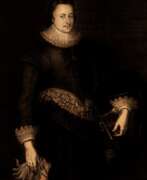

Martin Lister was a British naturalist and physician.
It could be argued that Lister founded two fields of natural history: arachnology (the study of spiders) and conchology (the study of the shells of organisms). He wrote more than 60 articles in the Philosophical Transactions of the Royal Society of London, published several volumes on natural history, speculated on the mysterious nature of fossils, and was successful as a physician.
Lister employed his artist daughters to illustrate his books on insects and molluscs - the names of Susanna and Anne appear on the title pages of the volumes. The Lister family published Historiæ Conchyliorum between 1685 and 1692.
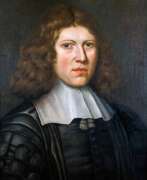

Richard Lower was a British physician, anatomist and physiologist who developed methods of blood transfusion.
Lower studied medicine at Oxford, moved to London in 1666 and began practicing medicine, soon becoming a successful physician and a Fellow of the Royal Society. Lower is particularly known for his work on the brain and nerves, which he performed as an assistant to Thomas Willis at Oxford while studying medicine. His anatomical and physiological study of the structure and action of the heart was one of the earliest discoveries, and he himself was recognized as one of the most skilled vivisectors of his time.
Lower was involved in the earliest experiments in blood transfusion, following Christopher Wren's similar studies a few years earlier. In February 1665, Lowther performed the first transfusion of blood from an artery of one animal into a vein of another, and in 1666 he also participated in the first experimental transfusion of blood to man.
Lower was a pioneer of experimental physiology. In his book Tractatus de Corde (1669), he described his pioneering work on blood transfusion and the function of the cardiopulmonary system. Also described is a series of experiments conducted with Robert Hooke in which he showed that the color of arterial blood is due to its contact with "fresh air" in the lungs.
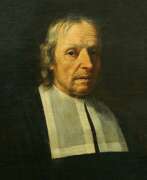

Marcello Malpighi was an Italian biologist, anatomist and physician, professor of logic, theoretical and practical medicine, and a member of the Royal Society of London.
After graduating from the University of Bologna with the degree of Doctor of Medicine and Philosophy, Malpighi soon took up a professorship there, then taught at the universities of Pisa and Messina. At the same time as teaching, he conducted biological research with his microscopes, which was an innovation in those days. In 1661, he identified and described the pulmonary and capillary network connecting small arteries to small veins, one of the most important discoveries in the history of science. He also isolated taste buds and regarded them as nerve endings, described the minute structure of the brain, the optic nerve, and in 1666 was the first to see red blood cells and attribute to them the color of blood. His treatise De polypo cordis (1666) explained the composition of blood and how it coagulates.
During his medical practice, Malpighi studied microscopic sections of the liver, brain, spleen, kidneys, and the bone and deep layers of skin that now bear his name. In his landmark 1673 work on the embryology of the chicken, the scientist concluded that the embryo forms in the egg after fertilization. In 1675-79 he also made extensive comparative studies of the microscopic anatomy of several different plants and saw analogies between plant and animal organisms. The Royal Society of London published two volumes of his botanical and zoological works in 1675 and 1679. His Anatome Plantarum is richly decorated with engravings by Robert White.
After his house was burned and looted by his adversaries, in 1691 Pope Innocent XII invited him to Rome as papal personal physician, which was a great honor.
Malpighi can be considered the first histologist. For almost 40 years he used the microscope to describe the main types of plant and animal structures and thus marked for future generations of biologists the main directions of research in botany, embryology, human anatomy and pathology. The conflict between ancient ideas and modern discoveries continued throughout the seventeenth century. Malpighi was convinced that microscopic anatomy, by showing the minute structure of living things, questioned the value of the old medicine. He laid the anatomical foundation for the subsequent understanding of human physiological exchanges.
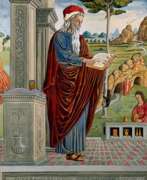

Yuhanna ibn Masawaih (Arabic: يوحنا بن ماسويه), also written as Ibn Masawaih, Janus Damascene or Mesue, Masuya (Masawaih, Masawaiyyh, Latin. Janus Damascenus, or Mesue, Masuya, Mesue Major) was a Persian or Assyrian East Syrian Christian physician.
Born into the family of a pharmacist and physician from Gundishapur, Masawaih's father was Assyrian and his mother Slavic. In Baghdad he studied under the Nestorian physician Jabril ibn Buhtishu (8th century). After becoming the director of a hospital in Baghdad, he was also the personal physician of four caliphs.
He wrote medical treatises on a number of topics, including ophthalmology, fever, leprosy, headache, melancholia, dietetics, physician testing, and medical aphorisms. One of the treatises deals with aromatic substances and is entitled On Simple Aromatic Substances. Masawaih translated various Greek medical works into Syriac, but wrote his own work in Arabic.
Many anatomical and medical works are attributed to him, notably The Disease of the Eyes, the earliest systematic treatise on ophthalmology extant in Arabic, and Aphorisms, whose Latin translation was very popular in the Middle Ages. Masawaih's books became a major conduit of Arabic knowledge to the Latin-speaking world and formed the basis of pharmaceutical education in the early modern period. His works, best known for his knowledge of ophthalmology, gynecology, and anatomy, are among the earliest Arabic medical texts available in Europe.
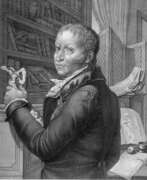

Paolo Mascagni was an Italian physician and anatomist.
He graduated from the University of Siena in philosophy and medicine, becoming a professor of anatomy there and focusing on the human lymphatic system. Mascagni outlined his discoveries in a book with detailed illustrations of each part of the lymphatic system he identified. In studying the lymphatic system, Mascagni refined the technique: he injected mercury as a contrast agent into the peripheral lymphatic networks of a human cadaver and, by tracing the movement of mercury into other parts of the system, was able to create detailed diagrams and models. By studying physiology and pathology, he was able to emphasize the importance of the lymphatic system in combating diseases of the human body, which helped to develop new treatments.
Mascagni helped to enrich the collection of wax anatomical figures in the Florence Museum, and commissioned the sculptor Clemente Susini to make a full-scale model of the lymphatic system in wax, which can still be seen in the Museum of Human Anatomy at the University of Bologna. Mascagni created the Anatomia universale ("General Anatomy"), a huge unbound book of 44 copper sheets with anatomical illustrations. The scientist pursued the task of collecting in one book the entire body of knowledge about the anatomy of the human body. Each plate is made in such a way that drawings relating to one plane of dissection can be placed together and show the whole body in life-size.
In addition to anatomy and medicine, Mascagni was interested in mineralogy, botany, chemistry, and agriculture.
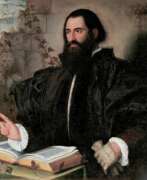

Pietro Andrea Gregorio Mattioli was a 16th-century Italian physician, botanist and pharmacist.
Mattioli studied medicine in Padua and obtained a medical practice first in his hometown. Later, in the 1555-1560s, he served as personal physician to the imperial court of Ferdinand II, Archduke of Austria, and Emperor Maximilian II. This high position allowed him to test the effects of poisonous plants on prisoners for scientific purposes.
Mattioli published several scientific works in which he included many of his own observations on the flora of the Alps, including previously unexplored plants. These works, based on the study of books by predecessor scientists, gave impetus to the development of botany throughout Italy at the time. Mattioli kept up a lively correspondence with other researchers, describing specimens of rare plants received from them. The genus of flowering plants Matthiola is named after Mattioli.
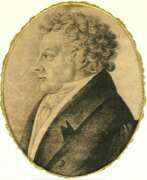

Johann Friedrich Meckel the Younger was a German anatomist, biologist and professor of anatomy.
Meckel came from a family of physicians; his grandfather and father were physicians and anatomists and had their own anatomical museum at home. Meckel studied medicine at the universities of Halle and Göttingen, writing his doctoral dissertation on congenital anomalies of the heart. As a pathologist, he specialized in the study of congenital malformations and aspects of lung and blood vessel development. He also described Meckel's diverticulum, which he discovered during a pathologic examination, and became the founder of the science of teratology.
After Napoleon's occupation, the University of Halle reopened in May 1808, and Meckel was appointed professor of surgery, normal and pathological anatomy, and obstetrics. He taught throughout his life, continued to conduct research in pathology, and collected specimens for his collection. The scientist was the author of numerous articles and several multi-volume treatises, including one on pathologic anatomy and an atlas depicting human anomalies. His principal labors were devoted to the comparative morphology of vertebrates. In 1810 he completed the translation of Cuvier's (1769-1832) five-volume Leçons d'anatomie Comparée from French into German.
Meckel was a member of the German Academy of Naturalists "Leopoldina," a corresponding member of the Paris Academy of Sciences, and a foreign member of the Royal Society of London.
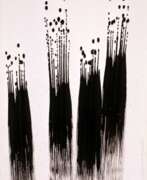

Walter Menne is a German abstractionist painter and pathologist.
Walter Menne has created forms that owe their existence to meditation and a sensitive set of tools. In Menne's work it is important that the tool should allow him to work quickly and without interruption, and that the ink should be applied in as many degrees of thickness and form as possible. These are not signs, but rather rhythms and melodies.
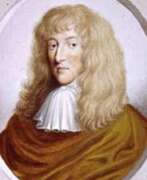

Christopher Merrett was a British physician and natural scientist.
Merrett was somewhat of a polymath and natural philosopher. His interests ranged from coinage and tin mining in Cornwall to glassblowing and butterfly taxonomy (his Pinax Rerum Naturalium Britannicarum of 1666 is now recognized as the earliest complete list of birds and butterflies in England).
However, he is much better known today as the first Englishman to record the existence of the sparkling wine phenomenon. It was Christopher Merrett in 1662 who first documented the existence of bubbles in an alcoholic beverage. He described the fundamental winemaking technique that was later called the "method of champanization" and perfected the production of stronger glass in the manufacture of wine fermentation bottles, which had previously exploded easily.
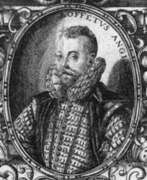

Thomas Moffet was a British naturalist-naturalist and physician.
After receiving his MD degree in 1580, Thomas Moffet studied the anatomy of the mulberry silkworm in Italy, then returned to England to study arthropods in general, especially spiders. He edited and expanded the work Insectorum sive Minimorum Animalium Theatrum ("Insect Theater"), an illustrated guide to the classification and life of insects.
Moffet was also an ardent supporter of the Paracelsian system of medicine.
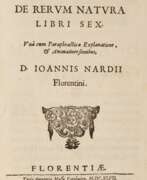

Giovanni Nardi was an Italian physician and natural philosopher.
After studying at the University of Pisa, Nardi worked as a physician in Florence. He corresponded with many of the leading natural philosophers and antiquarians of his time, including members of the Accademia dei Lincei. In 1620 Nardi became court physician to Duke Ferdinando II Medici of Tuscany and accompanied him on his travels. In his Florentine home, Nardi amassed a collection of antiques and curiosities.
Nardi wrote several volumes on natural philosophy, as well as a commentary on Lucretius entitled Titi Lucretii Cari De rerum naturae libri sex (1647). Nardi's commentaries on Lucretius's natural history, medicine, physics, and theory of atomism far exceed the poem itself.
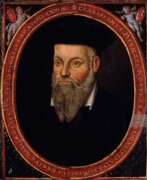

Nostradamus (French: Michel de Nostredame) was a French physician-pharmacist, writer, poet, astrologer and alchemist.
Nostradamus was born into a family of baptized Jews and studied various sciences in Avignon. At that time the plague was rampant in Europe, and Nostradamus decided to become a healer, in 1526 he even invented an anti-plague medicine, and later received a degree of Doctor of Medicine. He began his medical practice around the 1530s in Agen. During the plague outbreaks in Aix and Lyon in 1546-1547, he gained fame for his innovative treatments. Nostradamus described his methods of dealing with epidemics in several medical works. In addition to medicine, he also practiced astrology.
Nostradamus gained worldwide fame thanks to his gift as a seer. He began making prophecies around 1547 and first published them in 1555 in a book called Centuries. The book was written in rhymed quatrains - catrines - with predictions of future events in European history. Some of his prophecies were close to the truth, and the fame of the visionary Nostradamus reached the court of Catherine de Medici, who ordered him to compile horoscopes of her children. In 1564 he was appointed physician to Charles IX, to whom he also made several predictions that came true.
Nostradamus's book of prophecies was a huge success, and it still arouses interest, but he wrote allegorically and many of the katrines cannot be interpreted unambiguously.
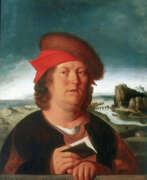

Paracelsus, born Theophrastus von Hohenheim (full name Philippus Aureolus Theophrastus Bombastus von Hohenheim), was a Swiss physician, alchemist, lay theologian, and philosopher of the German Renaissance.
He was a pioneer in several aspects of the "medical revolution" of the Renaissance, emphasizing the value of observation in combination with received wisdom. He is credited as the "father of toxicology". Paracelsus also had a substantial influence as a prophet or diviner, his "Prognostications" being studied by Rosicrucians in the 1600s. Paracelsianism is the early modern medical movement inspired by the study of his works.
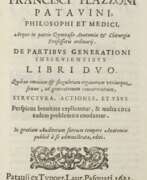

Francesco Plazzoni was an Italian physician and anatomist.
Plazzoni was a fellow student of Fabrizi and colleague of Spigellius, and taught in Padua. He is the author of the treatise De partibus generationi inservientibus libri duo (Padua, 1621). His text is based on Plazzoni's anatomical lectures in Padua and deals with the physiology of the penis, the clitoris, and sexual arousal.
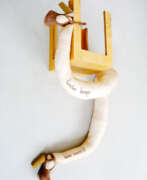

Tyyne Claudia Pollmann is a German conceptual artist and professor of anatomy and morphology in the Department of Art Fundamentals at the Berlin Weissensee School of Art.
She has been working as a freelance artist since 1990 and usually performs multi-year interdisciplinary art and science projects, in particular interactive installations.
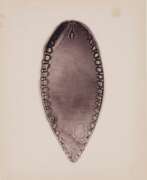

John Thomas Redmayne was a British surgeon, physician and amateur naturalist.
Redmayne trained as a physician and surgeon in Glasgow, then received his diploma at Guy's Hospital in London and was licensed by the Royal College of Physicians in Edinburgh.
In addition to being a physician, J. Redmayne was an amateur naturalist, he became interested in microscopy and specialized in diatom algae. He is considered one of the most successful microphotographers of the time, and his founding of the Bolton Microscopical Society allowed him to concentrate on the study of diatoms. His microscopic diatom plates were highly respected, particularly for the relative purity of the species. He also mounted histological preparations. Redmayne gave copies of his book to the Quekett Microscopical Club (which he joined in 1876) and the Royal Microscopical Society.
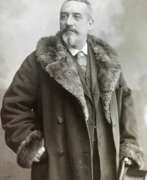

Paul Regnard, full name Paul Marie Léon Regnard, was a French physician, physiologist and photographer, and teacher.
He became a trainee at the hospital in 1874 and received his MD degree in 1878. Paul Regnard was deputy director of the Hautes Etudes Laboratories, and from 1878 taught general physiology at the newly founded National Agronomic Institute and later became its director (1902). He was also from 1895 a member of the Academy of Medicine in the section of biological sciences.
Regnard was one of the first practitioners of medical photography, particularly photographs of the mentally ill. Together with Désiré-Magloire Borneville, he directed the photographic service at the Salpêtrière Hospital of Paris, established by the psychiatrist J.C. Charcot (1825-1893). Numerous photographs were published in the book Iconographie Photographyique de la Salpêtrière. Regnard was a tireless researcher. He was one of the first naturalists to study the effects of atmospheric pressure on microbial metabolism. The scientist made a detailed historical and bibliographical survey of descriptions of possession and witchcraft through the ages, focusing on well-documented cases.
Regnar was particularly interested in the physical manifestations described by contemporaries: fainting spells, tetany, paresthesias, signs that could only be interpreted as diabolical or at least miraculous. All these signs Regnard had already observed, photographed, and treated at the Salpêtrière Hospital in the department of J.M. Charcot, to whom he dedicated this work, and so it was from the perspective of nascent psychiatry that Regnard analyzed these historical cases.
For his services, Regnard was made a Chevalier of the Legion of Honor in 1884, then an officer in 1900.
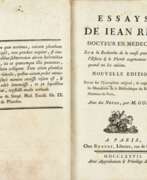

Jean Rey was a French chemist and physician.
Rey received a Master of Arts degree from the Academy of Montauban, then a doctorate from the University of Montpellier, and worked as a physician in his hometown of Le Bug. He was also engaged in chemical research, corresponded with R. Descartes, M. Mersenne and others.
Jean Rey was the first to express the idea of conservation of mass as applied to chemical reactions. While conducting experiments in his brother's forge, he discovered that the mass of lead and tin increases with calcination. The researcher explained this based on the assumption that air has mass and that lead and tin combine with air during calcination. In 1630 Rey published a treatise on this topic, "Experiments to find the reasons for the increase in the weight of tin and lead during calcination". As can be seen from the treatise, he realized that substances are made up of particles. His discovery of the weight of air also made possible the invention of the Torricelli barometer in 1643. Jean Rey also developed a device called the thermoscope, a precursor to the thermometer.
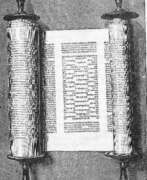

Paolo Ricci (Italian: Paolo Ricci, Latin: Paulus Ricius, German: Paul Ritz), also known as Ritz, Riccio, or Paulus Israelita, was a humanist convert from Judaism, a writer-theologian, Kabbalist, and physician.
After his baptism in 1505 he published his first work, Sol Federis, in which he affirmed his new faith and sought through Kabbalah to refute modern Judaism. In 1506 he moved to Pavia, Italy, where he became a lecturer in philosophy and medicine at the university and met Erasmus of Rotterdam. Ricci was also a learned astrologer, a professor of Hebrew, philosophy, theology, and Kabbalah, a profound connoisseur and translator of sacred texts into Latin and Hebrew, and the author of philosophical and theological works.
Paolo Ricci was a very prolific writer. His Latin translations, especially the translation of the Kabalistic work Shaare Orach, formed the basis of the Christian Kabbalah of the early 16th century.
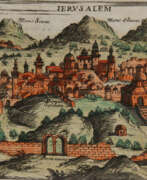

Giuseppe Rosaccio was an Italian physician, astronomer, cosmographer and cartographer.
Rosaccio graduated from the University of Padua, studied philosophy, medicine and law, and worked as a physician and judge. He became famous for a series of works that popularized a number of scientific disciplines. Some of his books deal with astrological medicine, specific diseases and their remedies, and the distillation of medicines from plants.
Giuseppe Rosaccio wrote about forty works on various topics of interest to him, but the main one was geography. He wrote an essay on the Muslim religion and treatises on geography, cosmography, astronomy, and astrology, which became very popular and were repeatedly reprinted.
Rosaccio created many atlases and small-format geographical works. Among his works is Ptolemy's Geography, which contains many indexes and is written in Italian (1599). He also authored a large map of the world (1597), and a large map of Italy and Tuscany (1609). His book Journey from Venice to Constantinople includes maps of the route with brief texts, that is, it is essentially an illustrated version of a pilgrimage to the Holy Land.
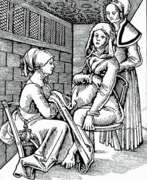

Eucharius Rösslin the Elder or Eucharius Rößlin was a German medieval scholar, physician-midwife, and pharmacist.
In 1493 Eucharius became apothecary in Freiburg, and 13 years later was elected physician of the city of Frankfurt am Main. From there he moved to Worms, in the service of Katherine, Princess of Saxony and Duchess of Brunswick and Lüneburg. One of his duties was to oversee and supervise the city's midwives, whose ignorance led to a high infant and female mortality rate.
In order to remedy this, Eucharius wrote and published a book on midwifery called Der Rosengarten ("The Rose Garden for Pregnant Women and Midwives") in Strasbourg in 1513. It was in German and contained several engravings. The book proved very popular and soon became the standard medical textbook for midwives. For nearly two centuries it was the authoritative guide to midwifery in Europe, translated into seven languages and reprinted over a hundred times.
In 1517 Rösslin returned to work in Frankfurt and remained in that position until his death in 1526. His son, also named Eucharius Rösslin, succeeded him as city physician.
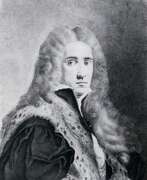

Giovanni Dominico Santorini was an Italian anatomist and professor.
Santorini studied medicine in Bologna, Padua and Pisa, earning his doctorate. One of his teachers was Marcello Malpighi (1628-1694). In 1703 Santorini began anatomical autopsies and was a demonstrator of anatomy in Venice from 1706 to 1728. In 1728 he became proto-medic and physician to Spedaletto in that city.
He was considered one of the most industrious and meticulous anatomists of the eighteenth century. Santorini's anatomical studies include many muscular and venous structures, cartilage, and glands of the human body. In addition to detailed descriptions of these structures, he also produced magnificent copper plates and illustrations. In 1724, Santorini published Observationes anatomicae ("Anatomical Observations"), a work that included anatomical aspects of the human body.
Giovanni Santorini's work greatly expanded knowledge of human anatomy, and several organs are named after him. Santorini was also a popular pioneer in the teaching of obstetrics.
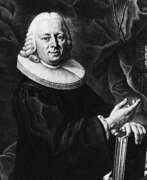

Jacob Christian Schäffer was a German inventor, naturalist, entomologist and mycologist.
Schäffer was a very versatile scientist. He is best known for his work in mycology (the study of fungi), but his most important publication was undoubtedly a book on daphnia or water fleas.
Schäffer also published reference books on pharmaceuticals and medicinal herbs. He conducted experiments on electricity, colors, and optics, and invented the manufacture of prisms and lenses. He invented the washing machine, designs for which he published in 1767, and studied ways to improve paper production.
Schäffer was a professor at the Universities of Wittenberg and Tübingen, a member of the Royal Society of London, and a correspondent of the French Academy of Sciences.
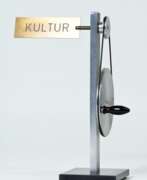

Konrad Balder Schäuffelen is a German psychiatrist, artist, author of concrete and visual poetry, and translator.
Schäuffelen earned a PhD in medicine and worked as a psychiatrist at the Max Planck Institute for Psychiatry in Munich. After training as a psychotherapist and psychoanalyst, he worked in his own practice and as a writer and translator in Munich.
In the 1950s Schäuffelen turned to experimental and visual poetry; from the early 1960s he mainly produced language and book objects as well as audiovisual installations. In 1979 he was awarded the Schwabing Art Prize in the plastic/sculpture category.
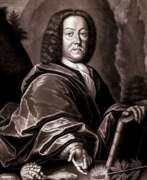

Johann Jakob Scheuchzer was a Swiss naturalist and geologist, paleontologist and fossil collector.
Scheuchzer studied at the University of Altdorf near Nuremberg, earned a doctorate in medicine at Utrecht University, and studied astronomy. He worked as a teacher, physician, and corresponded extensively with many scientists, writing several papers, including those on Swiss research, weather, geology, and fossils. Scheuchzer collected fossils during his extensive travels. And, as a proponent of diluvialism, he believed that all fossils and layers of the earth were formed by the Flood.
Between 1731 and 1735, Scheuchzer published a massive four-volume work called Physica Sacra, which is essentially a commentary on the Bible. It presented the facts of natural history along with passages of scripture. Thus Physcia Sacra attempted to reconcile the Bible with science.
This book is also called the "Copper Bible" because it contains over 750 magnificent color engravings on copper plates. These engravings are in themselves the pinnacle of engraving from the Baroque period. The illustrations depict scenes with biblical and scientific motifs. They were based on his own cabinet of natural history and other famous European cabinets of rare specimens. The engravings were produced by highly skilled engravers, including Georg Daniel Heumann and Johann August Corwin.
During his lifetime, Johann Jakob Scheuchzer wrote 34 scientific papers and many articles, and he was a member of the Royal Society.
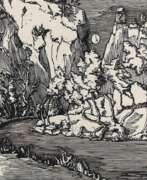

Hans Otto Schönleber was a German graphic artist, engraver and physician.
Hans Otto was the son of landscape painter Gustav Schönleber (1851-1917), first received a medical education and worked as a doctor. After World War I, after serving as a soldier, he trained as an engraver in Munich in 1920. He created etchings of fine work mostly of lush landscapes.
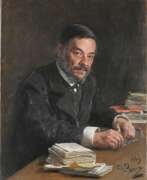

Ivan Mikhailovich Sechenov (Russian: Иван Михайлович Сеченов) was a Russian natural scientist, psychologist and physiologist, teacher and educator.
Ivan Mikhailovich was born into an impoverished noble family in the village of Teply Stan, Kurmysh uyezd, Simbirsk province (now the village of Sechenovo, Nizhny Novgorod region), graduated from the Main Military Engineering School, then from the Medical Faculty of Moscow University. For three and a half years Sechenov studied in Germany, engaged not only in biological disciplines, but also in physics and analytical chemistry. Abroad he became friends with S. P. Botkin, D. I. Mendeleev, A. P. Borodin, and the artist A. Ivanov.
In 1860 in St. Petersburg at the Imperial Academy of Medicine and Surgery Sechenov defended his dissertation on "Materials for the Physiology of Alcoholic Intoxication" and received the degree of Doctor of Medicine. Soon he received the post of extraordinary professor at this academy and organized one of the first physiological laboratories in Russia in his department. His record includes work in the laboratory of D. I. Mendeleev, head of the Department of Physiology at Odessa Novorossiysk University, teaching at St. Petersburg University, and professor in the Department of Physiology at Moscow University. Sechenov gave much effort to the development of women's education. He participated in the organization and work of the Higher Women's Courses in the capital, taught at women's courses at the Society of Educators and Teachers in Moscow.
Ivan Sechenov is the founder of the doctrine of mental regulation of behavior, the creator of the first physiological scientific school in Russia. For the first time in history he substantiated the reflex nature of conscious and unconscious activity. He showed that the basis of mental phenomena is physiological processes, substantiated the importance of metabolic processes in the realization of the body's reactions to stimuli. He laid the foundations of physiology of labor, age, comparative and evolutionary physiology. He studied the respiratory function of blood.
Sechenov's main works: "Reflexes of the brain" (1863), "Physiology of the nervous system" (1866), "Elements of thought" (1878), "Sketch of human working movements" (1901), etc. In addition, Sechenov edited "The physiology of the nervous system" (1866). In addition, Sechenov edited translations of books by foreign scientists. Thus, in 1871-1872 under his editorship in Russia was published a translation of Charles Darwin's work "The Origin of Man and Sexual Selection". Among his students were Ilya Mechnikov, Ivan Pavlov, Kliment Timiryazev, Nikolai Vvedensky, and Ivan Tarkhanov, who became famous scientists.
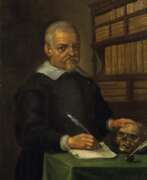

Marco Aurelio Severino was an Italian surgeon, anatomist and zoologist, one of the founders of comparative anatomy.
From childhood Severino studied Latin, Greek, rhetoric, poetry and law in various schools in Calabria, then continued his studies in Naples, soon moving from law to medicine. In Naples he met Tommaso Campanella, who had a great influence on the formation of his worldview. After receiving a medical degree in Salerno in 1606, he studied surgery in Naples with Giulio Jasolino. In 1615 Severino was appointed the first surgeon at Ospedale degli Incurabili. Severino made significant contributions to the transformation of naturophilosophy, medical and surgical practice, to which much of his printed work is devoted.
Severino's main contribution, however, lies in his anatomical works, especially the Zootomia Democritea. This work may be called the earliest comprehensive treatise on comparative anatomy. Severino is considered one of the pioneers of comparative anatomy.
Severino's cultural interests extended far beyond medicine. He corresponded with many prominent physicians and scientists of his time, including William Harvey and John Houghton in England, Thomas Bartolin and Ole Worm in Denmark, J.G. Volkamer and Johannes Wesling in Germany, and Campanella, Jasolino, and Tommaso Cornelio in Italy. Severino was tried by the Inquisition for allegedly unorthodox religious and philosophical views, but was eventually acquitted. He died of the plague in Naples.
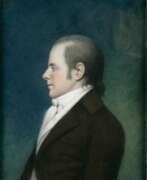

Elihu Hubbard Smith is an American author, writer, and physician.
Smith graduated from Yale College as early as age 11 with a liberal arts education, followed by a medical degree. He worked at New York Hospital and published historical articles on plague and plague fevers.
Elihu Smith was a very active writer: he was a member of the Hartford Witters, wrote the first American comic opera "Edwin and Angelina" (1796), was the editor of the first book anthology of American poetry ("American Poems, Selected and Original," 1793) and the first national American medical journal ("Medical Repository"), and corresponded extensively with many writers and writers of his time.
Smith died at age 27 of yellow fever, which he contracted while treating patients during an outbreak in New York City.
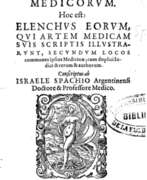

Israël Spach (also Israelis Spachius) was a German and French physician, medical writer and teacher of medicine.
Spach studied at the University of Tübingen, receiving the degree of doctor of medicine, and from 1589 taught medicine and Hebrew at the University of Strasbourg, with the rank of professor of medicine. He was characterized by a high bibliographical education.
Spach was the author of a gynecological encyclopedia, Gynaeciorum sive de mulierum tum communibus, tum gravidarum, parientium, et puerperarum affectibus et morbis, published in Strasbourg in 1597. It was a very significant book for its time.
Israël Spach also wrote Nomenclator scriptorum medicorum..., published in Frankfurt in 1591, which was the first attempt at a bibliography on medical subjects. It was organized under very broad subject headings, with indexes of authors and subjects.
